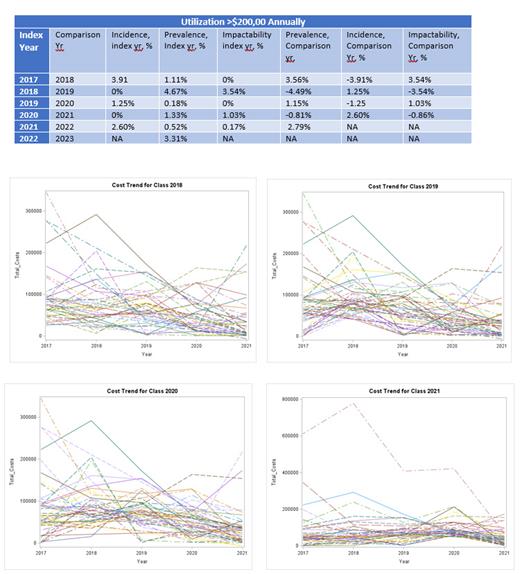Background: Utilization in adults with sickle cell disease (SCD) is driven by a biopsychosocial mix of predictors. Disease management intervenes on the biopsychosocial determinants of health, partly to drive down avoidable ED visits and hospitalizations. We previously reported the effect of disease management interventions on SCD utilization among adults enrolled in an Adult Sickle Cell Medical Home (Blood)[i]. To further understand the impact of these interventions, we evaluated the incidence, prevalence, and impactability of case management within our Medical Home.
Method:
The sample includes distinct individuals enrolled in the Adult SCD Medical Home (N=537 in 2017, N=621 in 2018, N=558 in 2019, N=677 in 2020, N=577 in 2021, and N=604 in 2022). We analyzed the “CoVID Years” (2020-2022) separately from the “Pre-CoVID” years (2017-2019). Interventions in the Adult SCD Medical Home included: medical care by MDs, NPs, and nurses; behavioral health counseling by a licensed clinical social worker; case management by Community Health Workers (Patient Navigators), and prior authorization management by a reimbursement specialist, a licensed pharmacy tech.
To perform the analysis, we defined High utilizers (vs moderate or low utilizers) as those with >$200,000 in annual medical charges each year between the years 2017-2021. We used the definition threshold to calculate the annual incidence of high utilization: the percentage of moderate or low utilizers in an index year who became high utilizers in the subsequent year. Similarly, the annual prevalence of high utilization was the percentage of all patients who were high utilizers in an index year. And the impactability of high utilization was the percentage of high utilizers in an index year who became moderate or low utilizers in the subsequent year. We calculated the annual high-utilization incidence, prevalence, and impactability for 2018-2022.
Results:
The annual program high-utilizer incidence, prevalence, and impactability are shown in Table 1. Utilization was stable from year to year, except at the intersection of pre-COVID and COVID years. The impactability score was 0-3.5%. We could not find good literature showing comparative annual changes in rates of impactability in diabetes, congestive heart failure, or vulnerable Medicaid populations.
The graphs show individual patients' index and multiple subsequent utilization costs for those remaining in the cohorts (Classes) starting from 2017-2022 (Class of 2018), 2018-2022 (Class of 2019), 2019-2022 (Class of 2020), and 2020-2022 (Class of 2021). No statistical analyses were performed, but the trends were numerically down for all periods.
Conclusion:
An intense disease management program, as part of an Adult Sickle Cell Medical Home was associated with stable year-over-year high-utilizer percentage. It was also associated with a stable, low annual incidence of ‘new’ high utilizers, and a stable, low impactability among current high utilizers. We could not determine how these program rates compare with analogous rates in other chronic diseases.
[i] Intensive Case Management in an Adult Sickle Cell Medical Home: Annual Effects on Utilization Efficiency Using Community Health Workers; Shirley Johnson, BA, LSW1*, Daniel M Sop, BS, MS2, Yue May Zhang, MS3*,Benjamin Jaworowski, BS 1*and Wally R Smith, MD4
Disclosures
Smith:Agios: Consultancy, Research Funding.


This feature is available to Subscribers Only
Sign In or Create an Account Close Modal